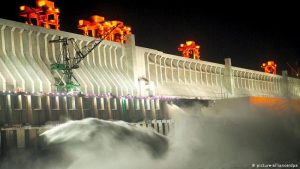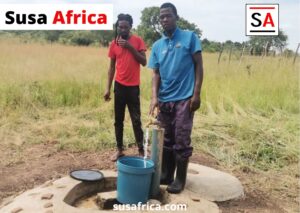Lesotho is well endowed with relatively abundant water resources. Economically, Lesotho depends on it’ water resources to create revenue for the country through the Lesotho Highlands Water Project (LHWP), a bi-national project divided into several phases, established by the 1986 treaty between the governments of the Kingdom of Lesotho and South Africa. But most people living in local communities don’t benefit and even have to get their own water from unprotected sources, from which waterborne diseases spread affecting the daily life.
The mountainous enclave-state of Lesotho is a democratic, sovereign and independent country with the unique characteristic of being totally surrounded by its neighbour, the Republic of South Africa. The country formerly known as Basutoland was renamed to the Kingdom of Lesotho upon independence from the UK in 1966. Almost 800 million cubic metres of water go from Lesotho to South Africa in a year, earning the landlocked country billions. In 2017, some 779 million cubic meters of water were transferred to South Africa and Lesotho received about M903 million in royalties. Most of these revenues come from the Lesotho Highlands Water Project, a multi-stage infrastructure project that transfers water, through a vast system of dams and tunnels, from Lesotho’s highlands to hydropower generation plants and industrial and mining operations in South Africa.
The Lesotho Highlands Water Project involved the construction of five dams and over 200 km (124 miles) of tunnels. The project was supported by the World Bank in partnership with Impregilo, an Italian company accused of corruption in 2004. At the start of the project, 3,000 hectares of arable land and 1,000 hectares of pasture land were flooded. Not all of the reviews of this project have been positive. Some studies have reported there may not have been enough foresight of the stress on water resources that drought and climate change could be causing.

Reduced river flows could affect communities that rely on the river for livelihoods, and some say this impact was not well understood before the project began. Most importantly, local communities did not receive economic compensation and the project worsened their already precarious living conditions. Phase II of the project is starting and there is no certainty that concerns of the affected population will be taken into account. Failures of Phase I risk to be repeated. It has been estimated that climate change decreased the number of farming households in Lesotho that were self-sufficient by 50%.

Over the years, Lesotho encounters an insecure supply of clean water and safe access to freshwater and sanitation raises the dangers of economic disruption, social tension, and even conflict over water resources at both the domestic and international levels. These dangers are highest where water is scarce and governance (at local, national or international levels) is poor. Water scarcity, aging or inadequate infrastructure, population growth, pollution, more intense and more frequent storms, droughts, and floods all these pressures are converging to lend urgency to the need to increase global investment in water infrastructures and to develop smart water conservation and management solutions.
Revealing the whole idea of how water projects affect local people is an important approach to gaining a full insight of the relationship between water infrastructure and sustainable livelihoods of local communities. Land and water resources are degrading because of prolonged droughts. Ecosystems are being pushed to their limits by over-cultivation, overgrazing, and over-harvesting, as communities are forced to adopt coping measures that push the land beyond its capacity. The dam does bring much-needed infrastructure, clean energy and jobs. But there are fears that without broad economic development, those benefits could disappear in the long-run, sending a wave of people from rural Lesotho to South Africa.
In Lesotho, the Department Rural Water Supply is responsible for ensuring that the rural communities get access to potable drinking water. However, the complexity of bureaucratic process of constructing water supply systems, project approval, availability of funds from the government and donors and maintenance culture are major factors promoting portable water scarcity to local communities in the country.
Thabo Letsoso, a Water and Environmental Engineer in Lesotho says, there are just too many processes involved before communities could have their water supply constructed. The little number of liaison officers and project officers means that it takes a very long time for feasibility studies and project survey and design to be completed.Due to climate change, springs or borehole’s which were used as sources of water over a long period of time may dry up and to get a new project, it takes a long time, even years, before could again have access to potable water and this leads them to resolve to unclean water or even forced to travel very far to get water from springs. In a time of breakdown, it takes a very long time before the maintenance could be done due to a few number of people responsible for maintenance.
Strengthening governance and sustainability improvement can aid in sustaining the livelihoods of affected villages. When a country has a water surplus in one area and a water shortage in another, supplies can be transferred. This is called a water transfer scheme. Reservoirs collect and store water in areas of high rainfall. Canals and pipes transport the water to rivers or reservoirs in other parts of the country. Water transfer schemes can be found in lots of different countries. The city of Las Vegas is able to exist in the Nevada Desert because water is transferred to it. Nature-based solutions, such as wetland restoration, mangrove conservation, and preserving flood plains can increase water availability and quality, and reduce the risks from water-related disasters. Water management is conducive to stability and peace building. Addressing short-term livelihood and food security needs is essential in the short-term. Sustainable water management is necessary for the long-term.
Based on World Bank report, improving Lesotho’s national water resources infrastructure and increasing water security in an environment of drought and floods and future climatic variations, is central to boosting the Government of Lesotho’s efforts to promote long-term sustainable macroeconomic development including food security and job creation. Lesotho must therefore re-evaluate its water sharing arrangements with South Africa. It should work with its neighbour to ultimately develop and implement a domestic water security policy which better protects its own citizens and national interests. That will not be easy, but a failure to do so could very well foreshadow an unprecedented humanitarian catastrophe in southern Africa.
Upgrading water supply infrastructure would boost access to and dependability of quality water. This is anticipated to save time and reduce illness among households, thereby raising incomes, and to increase business investment. Expert says that continued development of the Lesotho Lowlands Water Supply Scheme (LLWSS) is critical for the domestic and industrial sectors. While exploring interconnections between the Lesotho Highlands Water Project (LHWP) and the Lesotho Bulk Water Supply Scheme (LBWSS) could enhance resilience and balance the opportunities afforded through the regional transfer of water with national priorities. Full development of the LHWP will increase the transfer capacity and would also support development of water supply and irrigation schemes in the lowlands.
















[…] Why Water Shortage Increases in Lesotho’s Local CommunitiesWhy Water Shortage Increases in Lesotho’s Local Communities […]